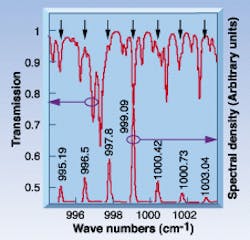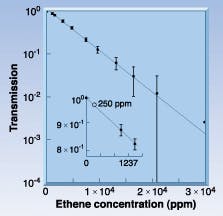
Researchers at the Technical University of Vienna in Austria claim to have made the first application of an electrically pumped gallium arsenide/aluminum gallium arsenide (GaAs/AlGaAs) quantum-cascade laser (QCL) in gas-sensing spectroscopy using hollow waveguides. For decades, laser spectroscopy has been a powerful tool for selection and detection of molecular signatures by virtue of the spectral density and narrow emission lines typical of lasers. Research in this field focuses on the mid-infrared (MIR) from 8 to 25 µm, the region in which organic compounds and many inorganic compounds exhibit strong absorption due to rotational-vibrational resonance.
Until now, MIR studies in molecular spectroscopy were limited to the application of lasers with fixed wavelengths, such as carbon dioxide and other gas lasers. Lubos Hvezdara, now at Georgia Institute of Technology (Atlanta, GA), says the recent advent of the GaAs/AlGaAs QCL has expanded the potential applications of MIR laser spectroscopy due to a capability for longer wavelengths, greater design flexibility, and less scattering in the quantum well.
Hvezdara and colleagues used laser light with an emission maximum at 10.009 µm to examine the mid-infrared absorption of ethene at atmospheric pressure. A 22.6-µm-wide, 1.15-mm-long ridge laser was operated in pulsed mode at a repetition rate of 5 kHz, with pulse duration of 100 ns, and a peak current density of 18 kA/cm2. A Fourier-transform infrared (FTIR) spectrometer in continuous scanning mode with a spectral resolution of 0.125 cm-1 recorded the emission spectra. The laser exhibits a typical Fabry-Perot resonator spectrum of eight longitudinal modes spaced 1.31 cm-1 apart, a characteristic tailored in this case specifically for measurements with a multimode Fabry-Perot GaAs/AlGaAs QCL.
A temperature change from 40 to 72 K leads to a redshift of the entire measured spectrum by 0.84 cm-1. This feature of the laser was used to tune the emission maximum to match an absorption peak in the spectrum of ethene. The team then used a 434-mm-long silver-coated silica hollow waveguide as a sensing element, which served as a gas absorption cell. The composition of the gas mixture was controlled and flushed through the absorption cell. The absorbance at each laser emission mode was measured for different concentrations of ethene.
Part of the vibrational spectrum of ethene was calculated by means of previous theoretical results and the Voigt profile. A relatively strong peak of absorption in ethene was predicted at 999.08 cm-1 and confirmed to overlap with the dominant emission of the laser gas-sensing system when operated at 62 K (see Fig. 1).The experimental results showed good agreement when compared with the calculated ethene spectrum. The detection threshold for the system was measured to be limited to 250 ppm (see Fig. 2). The researchers claim that a detection threshold of 20 ppm could be achieved by use of a laser that would match the main absorption peak of ethene at 949.2 cm-1.
About the Author
Valerie Coffey-Rosich
Contributing Editor
Valerie Coffey-Rosich is a freelance science and technology writer and editor and a contributing editor for Laser Focus World; she previously served as an Associate Technical Editor (2000-2003) and a Senior Technical Editor (2007-2008) for Laser Focus World.
Valerie holds a BS in physics from the University of Nevada, Reno, and an MA in astronomy from Boston University. She specializes in editing and writing about optics, photonics, astronomy, and physics in academic, reference, and business-to-business publications. In addition to Laser Focus World, her work has appeared online and in print for clients such as the American Institute of Physics, American Heritage Dictionary, BioPhotonics, Encyclopedia Britannica, EuroPhotonics, the Optical Society of America, Photonics Focus, Photonics Spectra, Sky & Telescope, and many others. She is based in Palm Springs, California.

